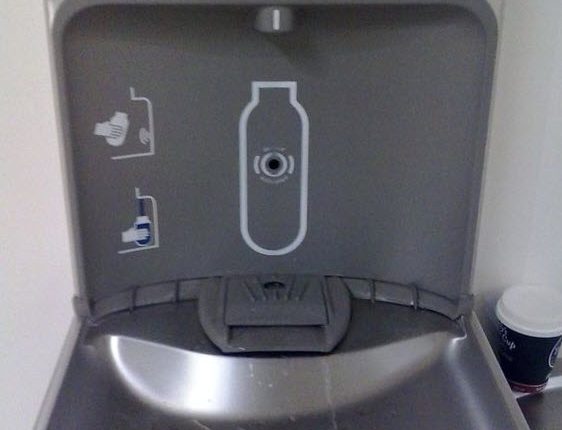Earth Day was Tuesday, which is a great time to remind you that it isn’t eco-friendly to use disposable plastic water bottles. What if you carried a reusable bottle with you everywhere instead?
This type of bland pitch to take care of the Earth’s resources doesn’t tend to be very effective. Sure, you may get the true believers to take action. But the vast middle segment of the population who somewhat care about the environment, but are lazy, likely won’t do anything different. Or, they might try it once or twice and then give up.
Shining a light on the hidden value of reusable water bottles
When I spoke recently at the University of North Florida, I noticed a marketing tactic so simple, yet so brilliant, that I wanted to share it with you today as the perfect example of revealing hidden value. Here’s a water fountain I saw at UNF.
Now, I admit, I haven’t really kept up on water fountain technology. But you’ll notice how this water fountain is different from when you and I went to college: It has a feature that allows students to refill water bottles with filtered water. But here’s the really brilliant part …
I learned that this model of water fountain is the Elkay EZH2O Bottle Filling Station. There is a counter on each water fountain (which the company calls the Green Ticker) that says, “Helped eliminate waste from 35,403 disposable plastic bottles.”
What is hidden value?
This is the perfect example of revealing hidden value. Hidden value is value that your product or service offers a customer, but they don’t know about it because you either:
- Don’t communicate it
- Communicate it through your marketing, but it is buried and de-emphasized
- Don’t track or compile the data at all
I believe that revealing this hidden value, which would have literally just flowed down the drain if the company didn’t track and message it, helped Elkay with two audiences:
- Water fountain users – By quantifying and showing the amount of trash that was saved, users clearly see how the effort they are making as a community (in this case, university) is actually making a difference. It also adds some social proof, showing that others are taking this action. For example, Elkay has a case study about how a campaign built around this water fountain reduced plastic water bottle consumption by 92% and 350,000 fewer plastic bottles were sent to landfills.
- Water fountain buyers – A water fountain is a B2B sale. Someone at UNF (and every other institution) had to decide to buy and install these water fountains. By quantifying a number that would have been lost, the purchaser is likely to be able to make an easier case to purchase more of these fountains, essentially showing the ROI to sustainability committees.
Now that you have a better understanding of hidden value, here are three ideas for revealing it more effectively in your marketing.
Idea #1. What value is buried in your marketing collateral?
Go on a treasure hunt. Sometimes the important elements of value are hidden in your marketing.
For example, by moving the number of members in a physician-only social network from a throwaway line out of the eye-path to the headline of the email, we were able to more than double conversion. You can see the control and treatment emails in “Email Messaging Test: 104% increase in conversion from rented list.”
Idea #2. What is the value of the next step in the process?
Another reason value is hidden is because prospective customers don’t know the value of the action you’re asking them to take; they only understand the costs.
This is especially true for product purchases, in which videos or images of the product in use and customer testimonials can help. You need to answer the question, “What’s it like to be a customer of your service or owner of your product?”
But it’s also true for something as simple as clicking a button. In this case, you need to answer the question, “What happens after I take this action?” In the email test I shared above, another element that helped increase conversion was changing the call-to-action button copy from “Get Started” to “See How [Product Name] Works.”
Idea #3. What value do customers not know they’re already getting?
Ever talk to someone who works at a company of a product you use, and they tell you all about the background information of the product, and this leaves you thinking, “Wow! I didn’t know it could do this”?
A great example is an experience I had with the folks who sell Acuvue contact lenses, which I wear. They had a booth at the Gate River Run here in Jacksonville, so I stopped by. They can’t sell contacts from the booth, you need a prescription. But they said the main reason they had the booth was simply to let people know that Acuvue contact lenses have UV protection, a hidden value most customers didn’t even realize.
You might also like
Transparent Marketing: How to make your product claims credible … not incredible [More from the blogs]
Lead Generation: Perceived value and cost of free incentives [More from the blogs]
Display Advertising: 4 common mistakes marketers make with banner ads [More from the blogs]
Email Messaging Tested – A recent experiment reveals the two words that increased email clickthrough by 13% [Web clinic replay]






They had those at my college…wait, I’m still in college. I hadn’t thought about the marketing value of the counter though. Thank you for the post!